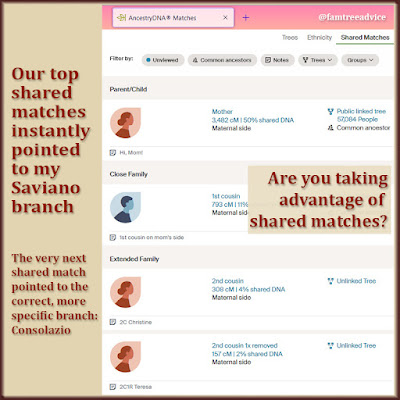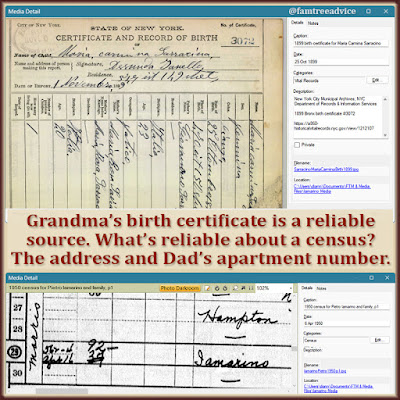I've had 16 homes in my life. And that's not counting college dorms or the months my family lived with relatives. It's a lot to keep track of. I do have a list of the 16 addresses along with some details in my ongoing biography Word document. But I wanted something better.
I turned to Google Earth for a far more visual way of storing these addresses. Now I can "fly" from home to home: starting in the Bronx where I was born, flying out to California, then back to the east coast, ever-so-briefly to Indiana, then several more stops on the east coast.
How can you use Google Earth for genealogy? You can create several collections of places, each with a unique name. I named my first collection Houses. What if you created a collection of all the addresses you have for a certain branch of the family? I could collect all the past addresses of my Ohio cousins or my western Pennsylvania cousins.
 |
| Take a virtual visit to your family's past anytime you choose. |
What I found infinitely enjoyable was collecting places from my vacations. I used my photos to help me remember and find hotels, restaurants, landmarks, and more. I was so excited to find the magical side street in Lyon, France, where I had the dinner of a lifetime. I'd forgotten the name of our hotel in Lyon, unfortunately. So I used Google Earth to roam the streets, pulling details from my memory, and I found it!
Preserving these details in this 100% visual way will be a treasure for the rest of my life. I did the same for a little town near Nice, France, and for Milano, Italy, but I have many more vacation destinations to do.
To start building your collections, you'll need a free Google account. Your collections get saved to your Google Drive. To save a place to a collection, use the magnifying glass icon to search for the address. Then choose Add to Collection. Click the Replace button (a misleading label) to change the title of the place, add a description, and even upload a photo. It can be your own photo or one you capture there in Google Earth.
I lived in California as an infant and didn't return to the west coast until 2016. I made sure to visit my old house and take a few photos. I attached the best one to this address in my collection. I also added something no one else can: a photo of the house under construction in 1959.
When you want to take a virtual tour of your saved places, open your collection. If it isn't already open, find it in Google Drive and double-click it to launch Google Earth. Once it's open in Google Earth, click the Present button.
 |
| Use family photos for landmarks and you can find those important places in Google Earth. |
The globe will spin and zoom in on the first location. You can use your mouse or the onscreen +/- buttons to zoom in or out some more. There will be a big panel on the right showing an image of the place or landmark. Sometimes you can click More info in this panel to scroll through photos of the place. Close that panel to see more options. You can drag and drop the little person icon to a spot on the map and have a street-side view of what's around. That works the same as it does in Google Maps.
Back in Present mode, you can keep clicking the right arrow until you've flown to all the locations. Or you can click the Table of Contents and choose any one of your saved places to visit.
Which collections would you like to create? How about adding places from your family photo collection? Imagine adding photos of the family gathered at that location. I guarantee you're going to have a lot of fun.
You can fly from one favorite place to another using Google Earth. Here's a flight from Lyon, France, to Milano, Italy.





